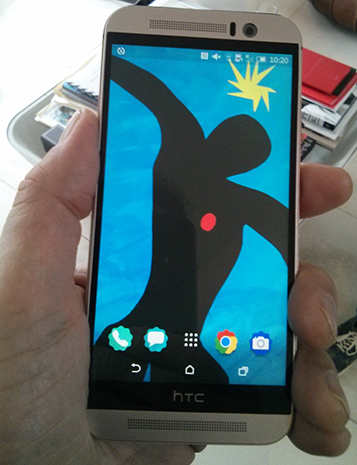HTC One M9: The evolution of a flagship smartphone

HTC's recent flagship smartphones have been consistently well received -- ZDNet gave Editors' Choice awards to both the 2013 One M7 and the 2014 One M8, for example. So, without pre-empting any hands-on reviews, the prospects for the M9 must be good -- especially if it can make it to market ahead of rival 2015 flagship handsets from the likes of Samsung, LG and Sony.
Apple-like design and engineering
Other defining characteristics of the HTC One family include excellent audio quality (under the BoomSound name), Android additions in the shape of HTC Sense (home screen, widgets, apps) and BlinkFeed (a news aggregator), and enlarged-pixel (UltraPixel) cameras that deliver superior low-light performance -- augmented in the One M8 with the Duo Camera system, where a second sensor detects depth-of-field information.
Key developments in the M9 include: enhanced personalisation options via HTC Themes and a new Theme Generator; a location-aware Sense Home feature that reconfigures the home screen and suggests associated apps depending on whether you're at work, home or in transit; the addition of '5.1-esque' Dolby Audio to the already-excellent BoomSound audio subsystem, along with the ability to select between available Bluetooth speakers via a 'swipe-up' gesture in HTC Connect; a revamped camera arrangement with a front-facing 4-megapixel UltraPixel camera and a 20-megapixel main camera (with digital rather than optical image stabilisation that was a feature of both the M8 and M7), plus a Dynamic Exposure algorithm for enhanced detail in multiple exposure points in an image, and a One Gallery feature that synchronises searchable thumbnails of your pictures from multiple sources -- Dropbox, Google Drive, Facebook, Flickr, for example -- into a single location.
The rest of the M9 specification is updated to leading-edge 2015 standard, of course. Here are the highlights, with the M7 and M8 included for comparison:
HTC One M7 | HTC One M8 | HTC One M9 | |
Announced | 19 February 2013 | 25 March 2014 | 1 March 2015 |
HTC share price | $282 | $152.50 | $153 |
| Dimensions | 137.4x68.2x9.3mm | 146.4x70.6x9.35mm | 144.6x69.7x9.61mm |
| Weight | 143g | 160g | 157g |
Display | 4.7 inches, Full HD 1080p (468ppi) | 5.0 inches, Full HD 1080p (441ppi) | 5.0 inches, Full HD 1080p (441ppi) |
Screen protection | Gorilla Glass 2 | Gorilla Glass 3 | Gorilla Glass 4 |
SoC | Qualcomm Snapdragon 600 (quad-core, 32-bit) | Qualcomm Snapdragon 801 (quad-core, 32-bit) | Qualcomm Snapdragon 810 (octa-core, 64-bit) |
GPU | Adreno 320 | Adreno 330 | Adreno 440 |
| OS | Android 4.1.2 (Jelly Bean) | Android 4.4.2 (KitKat) | Android 5.0.2 (Lollipop) |
OS add-ons | HTC Sense 5.0, HTC BlinkFeed | HTC Sense 6.0, HTC BlinkFeed | HTC Sense 7.0, HTC BlinkFeed |
RAM | 2GB | 2GB | 3GB |
Internal storage | 32/64GB | 16/32GB | 32GB |
Storage expansion | none | Micro-SD (up to 128GB) | Micro-SD (up to 128GB) |
| SIM card type | Micro-SIM | Nano-SIM | Nano-SIM |
Networks | |||
2/2/5G (GSM/GPRS/EDGE) | 850/900/1800/1900MHz | 850/900/1800/1900MHz | 850/900/1800/1900MHz |
3G (UMTS/HSPA) | 850/900/1900/2100MHz with HSPA+ | 850/900/1900/2100MHz with HSPA+ | 850/900/1900/2100MHz with HSPA+ |
4G (LTE) | 800/900/1800/2600MHz | 800/900/1800/2600MHz | FDD bands 1,3,5,7,8,20,28; TDD bands 38, 40, 41 |
GPS | internal GPS antenna + GLONASS | internal GPS antenna + GLONASS | internal GPS antenna + GLONASS |
Sensors | accelerometer, proximity, ambient light, gyro, compass | accelerometer, proximity, ambient light, gyro, compass, barometer | accelerometer, proximity, ambient light, gyro, compass, Sensor Hub |
Main camera | 4Mpixel UltraPixel sensor, HTC ImageChip 2, optical image stabilisation | 4Mpixel UltraPixel sensor, HTC ImageChip 2, optical image stabilisation, secondary 2Mpixel camera captures depth information (Duo Camera) | 20Mpixels, HTC Image Chip 2, digital image stabilisation, Dynamic Exposure, sapphire glass lens protection |
| Flash | 5-level LED (Smart Flash) | dual LED (dual tone) | dual LED (dual tone) |
Front camera | 2.1Mpixels | 5Mpixels | 4Mpixel UltraPixel sensor with Dynamic Exposure |
| Audio | HTC BoomSound: dual front stereo speakers with built-in amplifiers, Beats Audio, Sense Voice | HTC BoomSound: dual front stereo speakers with built-in amplifiers, Sense Voice | HTC BoomSound dual front stereo speakers with built-in amplifiers, Dolby Audio, Sense Voice |
| Wireless connectivity | 802.11a/b/g/n/ac wi-fi (2.4 & 5GHz), NFC, Bluetooth 4.0 with aptX, DLNA, HTC Connect, infrared | 802.11a/b/g/n/ac wi-fi (2.4 & 5GHz), NFC, Bluetooth 4.0 with aptX, DLNA, HTC Connect, infrared | 802.11a/b/g/n/ac wi-fi (2.4 & 5GHz), NFC, Bluetooth 4.1 with aptX, DLNA, HTC Connect, infrared |
| Other connections | Micro-USB 2.0 (5-pin) port with mobile high-definition video link (MHL) for USB or HDMI connection, 3.5 mm stereo audio jack | Micro-USB 2.0 (5-pin) port with mobile high-definition video link (MHL) for USB or HDMI connection, 3.5 mm stereo audio jack | Micro-USB 2.0 (5-pin) port with mobile high-definition video link (MHL) for USB or HDMI connection, 3.5 mm stereo audio jack |
| Battery | Li-polymer (non-removeable), 2,300mAh; up to 18h talk time (3G); up to 500h standby time (3G) | Li-polymer (non-removeable), 2,600mAh; up to 20h talk time (3G); up to 496h standby time (3G) | Li-polymer (non-removeable), 2,840mAh; up to 27h talk time (3G); up to 402h standby time (3G) |
For more detail and reactions, see Matthew Miller's news and hands-on articles on the HTC One M9. As Miller notes, there's no wireless charging on the One series, and unlike Samsung's and Sony's flagship phones, there's no water-resistance -- although personal experience with an M8 confirms that it can recover after a night left accidentally outdoors in the rain. If you don't want to take the risk, there's a ruggedised case that provides IP68-level protection.
Outlook
From what we've seen so far, the HTC One M9 looks likely to continue the success of its predecessors. Certainly owners of the One M7 who were uncertain about the M8's 4-megapixel Duo Camera should find the 20-megapixel M9 more to their liking. HTC's new 64-bit Snapdragon 810-powered flagship will also deliver a speed boost: results already posted on the Geekbench 3 results browser suggest improvements of around 22 percent on single-core performance and 35 percent on multi-core performance over the 32-bit Snapdragon 801-powered One M8. However, if it's performance you're after, look out for Samsung's Galaxy S6, likely to be powered by the company's own 64-bit octa-core Exynos 7420 processor: leaked Geekbench 3 benchmarks for this handset have shown it beating Snapdragon 810 devices by some distance. The Galaxy S6 range is expected to be unveiled at another 1 March MWC event: Samsung Galaxy Unpacked.
